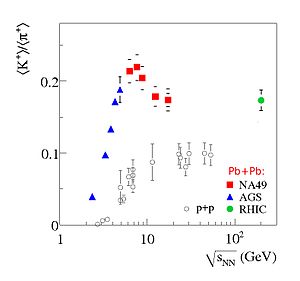- Onset of deconfinement
-
The onset of deconfinement refers to the beginning of the creation of deconfined states of strongly interacting matter produced in nucleus-nucleus collisions with increasing collision energy (a quark–gluon plasma).
The onset of deconfinement was predicted by Marek Gazdzicki and Mark I. Gorenstein to be located in the low energy range of the Super Proton Synchrotron (SPS) at the European Organization for Nuclear Research (CERN).[1] These predictions have been confirmed by the NA49 experiment at the CERN SPS within the energy scan programme.[2] The most famous of these is the "horn" (dubbed the "strange matter-horn") in the ratio of mean multiplicities of positively charged kaons and pions observed in collisions of two lead nuclei at the low energies of the SPS. The horn is not seen in proton–proton interactions.
References
- ^ M. Gazdzicki, M.I. Gorenstein; Gorenstein (1999). "On the early stage of nucleus–nucleus collisions". Acta Physica Polonica B 30: 2705. arXiv:hep-ph/9803462. Bibcode 1999AcPPB..30.2705G. http://th-www.if.uj.edu.pl/acta/vol30/abs/v30p2705.htm.
- ^ C. Alt et al. (NA49 collaboration) (2008). "Pion and kaon production in central Pb+Pb collisions at 20A and 30A GeV: Evidence for the onset of deconfinement". Physical Review C 77 (2): 024903. arXiv:0710.0118. Bibcode 2008PhRvC..77b4903A. doi:10.1103/PhysRevC.77.024903.
External links
Categories:- Quark matter
Wikimedia Foundation. 2010.

